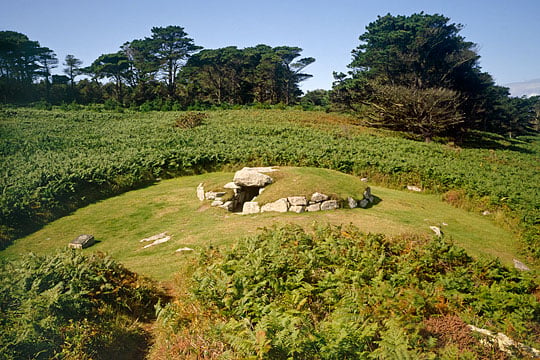History of Innisidgen Lower and Upper Burial Chambers
The chambered tombs or entrance graves at Innisidgen are two fine examples of the Bronze Age (around 2500–800 BC) ceremonial monuments built on hilltops and coastal plateaux on the Isles of Scilly.

What Are Entrance Graves?
Entrance graves are often described as Scillonian tombs because of their concentration on the islands, although a few are also found on the Penwith peninsula of west Cornwall. They are quite uniform in plan.
Most comprise a roughly circular mound retained by a stone kerb and built over a rectangular, stone-lined chamber which is roofed with large granite slabs. Some of the mounds are set within a large, kerbed platform.
Those entrance graves that have been excavated have contained cremated human bone and funerary urns. One such tomb, Knackyboy Carn on St Martin’s, was found to contain the cremated remains of at least 60 individuals.
Entrance graves seem to have continued in use on Scilly long after individual burial had become the usual practice on the mainland.
It is possible that the monuments may also have served much wider ritual and social functions, perhaps as territorial markers for the land of the founding kin groups and as places where offerings might be made.
The Innisidgen Graves
The two entrance graves at Innisidgen were constructed on a hill overlooking a coastal inlet, which had been inundated over the previous millennium. In earlier prehistory, this would have been a wide valley, possibly with walled fields.
Both sites were empty when first entered in modern times.
Upper Innisidgen Burial Chamber
The upper Innisidgen burial chamber, or Innisidgen Carn, is one of the best preserved entrance graves on Scilly. The mound measures 30 feet (9 metres) by 26 feet (8 metres), and is currently about 6 feet (2 metres) high. The surrounding wall or kerb is substantial: nearly 3 feet (1 metres) high on the north side.
Slight traces of an outer platform, up to 6 feet (2 metres) wide, surround the mound. A short, open passage on the eastern side leads to the entrance, which is covered by a massive slab. Four further capstones make up the roof of a rectangular burial chamber 15 feet (4.5 metres) long and about 5 feet (1.5 metres) high.
Lower Innisidgen Burial Chamber
Lower Innisidgen entrance grave, 300 feet (90 metres) to the north-west, is more damaged and retains only two of its capstones. Parts of the kerb of the mound survive, while the mound itself incorporates outcrops of rock.
The entrance to the chamber is on the south side. A prehistoric field system survives on the northern slope of the hill adjoining the entrance graves, visible as earth and rubble banks. The association of such funerary monuments with the farming landscape is a distinctive feature of the Isles of Scilly.
Further Reading
Ashbee, P, Ancient Scilly: From the First Farmers to the Early Christians (London, 1974)
Dimbleby, GW, A Buried Soil At Innisidgen, St Mary’s, Isle of Scilly (Redruth, 1977)
Sawyer, K, Isles of the Dead?: The setting and Function of the Bronze Age Chambered Cairns and Cists of the Isles of Scilly (Oxford, 2015)



